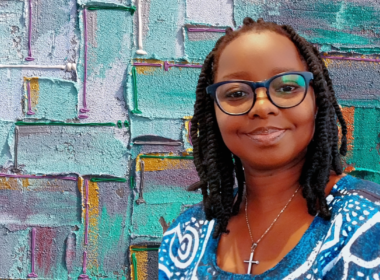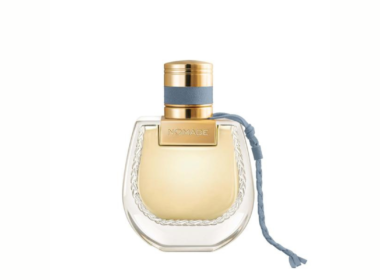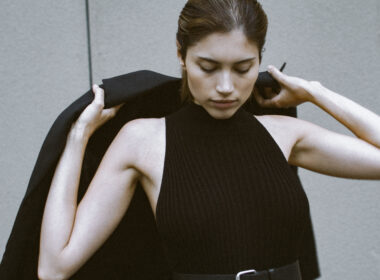Ndagijimana Alphonse, a Rwandan artist known for blending the traditional with the contemporary, brings his unique artistic voice to the Aux Gazelles’ Afriques Festival in Vienna. In this exclusive interview, Ndagijimana Alphonse shares how his roots, grounded in the art of sewing passed down by his tailor father, have shaped his unique artistic vision. His self-portraits, which blend traditional techniques with contemporary expression, offer more than just visual appeal; they are a dialogue between the old and new, Africa and the world, a reflection of how art can preserve and celebrate cultural heritage while embracing global narratives.

FAB: How did you go about selecting the pieces for this exhibition, and what was the curation process like?
Ndagijimana Alphonse: For this exhibition, I wanted to choose pieces that would best represent me as an African artist participating in an African art festival.
This was my first opportunity to exhibit alongside other African artists outside of Africa, and I was thrilled. I selected four different self-portraits, all created using a new technique I began developing after moving to Austria to study art. Transporting these works was more challenging than previous exhibitions, as they were larger in size and required greater care and expertise. Fortunately, with the experience I gained from Linz Art University and the support of the auxgazell team, the curation process felt like a magical transformation of the space.
FAB: What is the central theme or concept of your current exhibition at Aux Gazelle’s Afrique festival, and what inspired you to choose this theme?
Ndagijimana Alphonse: The central theme of my exhibition at Aux Gazelles is self-portraiture. This theme is a recurring focus in my artistic practice. The inspiration for these self-portraits comes from various elements and resources available to me as an artist, but most importantly, it comes from my father.
FAB: Are there any new works or series being showcased for the first time at this exhibition? If so, can you tell us about them?
Ndagijimana Alphonse: Yes, all the paintings in this exhibition are being shown for the first time.
These paintings were created at different times, but they all share the same technique. They belong to an ongoing series that includes self-portraits of my family, friends, and myself. In this series, I explore my childhood and present life, as well as my culture and the concept of cultural exchange, through the medium of 3D painting.
FAB: How does this exhibition reflect your views on contemporary Rwandan culture and its global connections?
Ndagijimana Alphonse: This exhibition embodies many interconnections for me as a Rwandan. Contemporary Rwandan culture is deeply focused on the development of young African ideas, and our government plays a significant role on the African continent in providing a voice, trust, and space for young people. As a contemporary Rwandan artist, I’m thrilled to share with other artists in this space what it means to be a Rwandan artist, both in Africa and beyond. Rwandan contemporary culture is heavily involved in sharing our African heritage within global connections.
More Like This:
Fashion Designers – Which Exhibitions Are Right For You?
CountryWizzy Takes Europe by Storm: Electrifying Debut at Afriques Festival
In conversation with Baba Diedhiou at the Afriques Festival – Aux Gazelles
FAB: Your art documents the evolving way of life. What are some of the most significant changes you’ve observed in East African society that you aim to portray in your work?
Ndagijimana Alphonse: I began travelling around East Africa at an early age with my family, and they often told me about the difficulties they faced. I can only imagine it because none of them recorded or captured images from that time—it was simply impossible. The most significant changes I’ve observed in East African society include the evolution of our culture, the union of East African people, and the region’s rapid development.
Today, it’s possible to travel and document our daily lives and ideas for future generations. Through my work, I aim to capture and record these changes that have shaped our lives.
FAB: How do you see your art contributing to the preservation and celebration of African cultural heritage, both within Africa and on a global stage?
Ndagijimana Alphonse: I believe my art plays a significant role in the development of African art both within the continent and globally. Having had the opportunity to study art in both Africa and abroad, I bring together knowledge and cultural experiences from different parts of the world. This unique perspective allows me to contribute meaningfully, especially to young Africans who are eager to learn about art, while also showcasing African culture on the global stage.
Ndagijimana Alphonse: Yes, the piece that holds the most personal significance for me is titled The Workmate of My Father. This piece is special because, before I became an artist, I used to work alongside my father, who is a tailor. He taught me how to use a sewing machine at a very young age. One day, I decided to create a portrait of his workmate while he was sewing with an old Singer sewing machine. During the process of creating this portrait, I discovered a new painting technique that I now use in my work.
FAB: Are there any specific techniques or materials you used in this exhibition that are new or experimental for you?
Ndagijimana Alphonse: Yes. As I mentioned earlier, the series of portraits I’m working on is ongoing. Inspired by my father, I began experimenting with a new technique that combines classic oil painting with textiles, sewing patterns, and collages.
FAB: Sewing plays a significant role in your artistic process. What does sewing symbolise in your work, and how does it contribute to the narratives you create?
Ndagijimana Alphonse: For me, sewing is one of the best ways to bring things together, whether they are broken or not. It can make them stronger, larger, or even transform them into something completely new. Sewing is symbolic of life itself; when you piece together all the small steps you’ve taken, they collectively tell the story of your life. This narrative is a key element in shaping who you are. In my art, sewing contributes to this narrative because it was the first skill I learnt at a young age, long before I ever thought of becoming an artist, and it has played a crucial role in my artistic journey.
FAB: How do you decide which elements to sew, paint, or collage?
Ndagijimana Alphonse: My artistic process begins with collecting ideas or images that interest me—these could be images I capture while travelling or those that come from family members, friends, or even myself. Once I have these ideas, I start developing my painting in the studio by selecting the materials I want to use. These materials include oil paint, canvas or different fabrics, sewing machines, ink, and other unique items I find.
The decision of whether to sew, paint, or collage an element depends on the composition of the work, and this is the most exciting part of my process. It’s important for me to consider each element carefully—what it represents and how it will impact the overall image. Based on the structure of the materials and my vision for the final piece, I then decide where to sew, paint, or collage.
FAB: What emotions or messages do you hope to evoke in the audience through your work in this exhibition?
Ndagijimana Alphonse: I hope to convey the freedom of creative expression, encouraging the audience to feel a deep connection and involvement with my art.
FAB: Have you received any feedback from viewers so far? What has been the most surprising or memorable reaction?
Ndagijimana Alphonse: Yes, I’ve been fortunate to receive feedback. The most memorable response came from viewers who felt a strong connection with my painting of me watering a plant. It resonated with them, perhaps because it reflects a universal experience—many people have plants they nurture.
FAB: How does exhibiting your work in Vienna differ from showcasing it in other parts of the world, particularly in Senegal or other African countries?
Ndagijimana Alphonse: Exhibiting in Vienna has a unique significance for me due to the cultural connections between Austria and my current life. My work reflects my present circumstances, and since I live in Austria, Austrian viewers often recognise elements of their culture within my art. Unfortunately, I haven’t yet had the opportunity to exhibit outside Austria since I began focusing on my career while studying at the Art University Linz. However, I look forward to bringing what I’ve learnt back home to share with my community in the future.
FAB: How does this exhibition fit into your broader artistic journey and future projects? What directions do you see your work taking after this?
Ndagijimana Alphonse: As a contemporary Rwandan artist, exhibiting alongside other international African artists is a crucial milestone in my journey. It provides answers to questions I’ve had about collaborating with other African artists and creates opportunities for us to unite and plan for a larger, shared future. While I can’t predict exactly how my work will evolve after this exhibition, I can say that each exhibition offers valuable resources. I use these resources to refine my work, drawing from the latest technologies and the feedback I receive. This process ensures that I continue to grow and improve with each new project.
FAB: Who or what are some of your biggest inspirations in the art world, and how have they influenced your artistic journey?
Ndagijimana Alphonse: My inspirations shift depending on what I’m currently focused on. We have access to so much information today, and I also visit many museums across Europe and Africa. However, some of my most enduring influences are artists like Rembrandt, Gauguin, and Claudette Johnson.
Ndagijimana Alphonse: This exhibition offers the Viennese audience an opportunity to experience African culture and art without the need to travel to Africa. For me, it’s a moment of gratitude, as it allows Austrians to engage with and appreciate African culture. My art serves as a proof of what can happen when spaces are opened up for diverse voices and experiences.

























